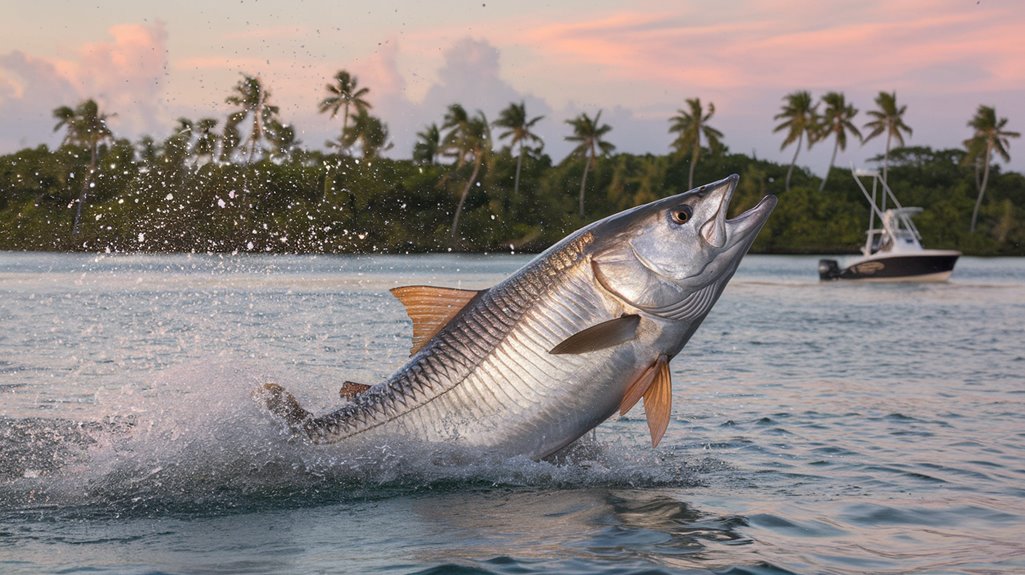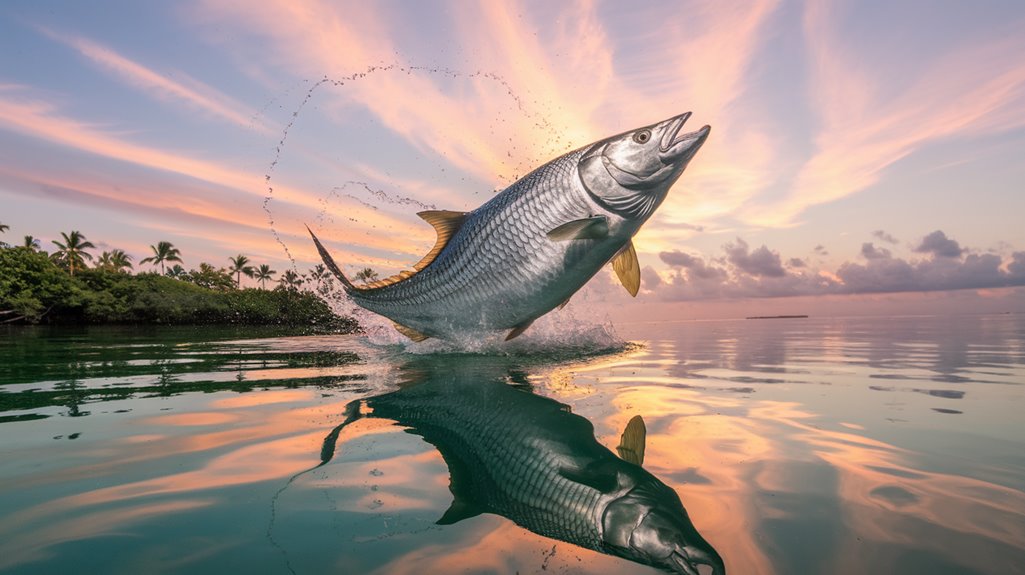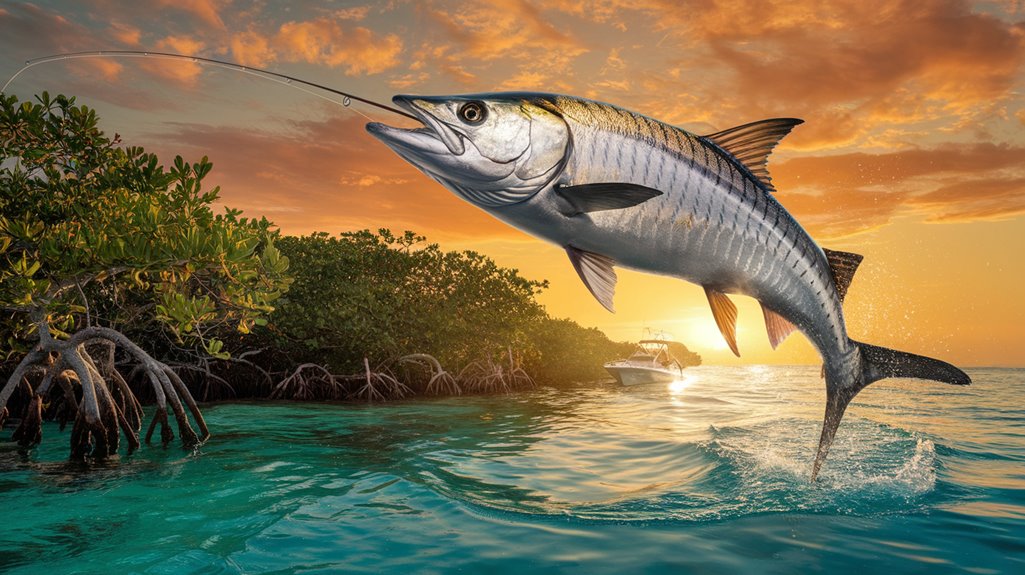You'll find the world's finest tarpon fishing across the Americas, from Florida's legendary Boca Grande Pass to Cuba's unspoiled Jardines de la Reina. These silver kings, reaching weights over 200 pounds, challenge anglers with their explosive strikes and acrobatic displays. Whether you're casting to juveniles in Mexico's mangroves or battling monsters off Costa Rica's coast, you're entering a pursuit that's tested generations of skilled fishermen. The path to landing your dream tarpon begins with knowing where and when to pursue them.
- Key Takeaways
- Top Tarpon Destinations Across the Americas
- Understanding Tarpon Migration Patterns
- Essential Gear and Techniques for Trophy Tarpon
- Peak Seasons and Weather Conditions
- Local Guides and Charter Services
- Conservation and Sustainable Fishing Practices
- Frequently Asked Questions
- Conclusion
Key Takeaways
- Boca Grande Pass, Florida offers premier tarpon fishing with peak action during late spring and summer for both resident and migratory fish.
- Jardines de la Reina, Cuba provides consistent action with juvenile tarpon ranging from 8 to 80 pounds in pristine waters.
- Costa Rica delivers opportunities for trophy-class tarpon exceeding 150 pounds, particularly after the rainy season in less pressured environments.
- The Belize coastline hosts excellent tarpon fishing from April through September, with specimens ranging from 30 to 100 pounds.
- Successful tarpon fishing requires experienced guides, proper gear (30-80 lb test line), and strategic timing during peak migration periods.
Top Tarpon Destinations Across the Americas

Five premier tarpon fishing destinations stretch across the Americas, each offering unique opportunities to pursue the Silver King. In Florida's Boca Grande Pass, you'll find peak action during late spring and summer, with both resident and migratory tarpon abundant in the waters. Belize's 200-mile coastline hosts impressive 30- to 100-pound specimens from April through September, while Cuba's Jardines de la Reina delivers consistent action with aggressive juvenile tarpon in the 8- to 80-pound range. Costa Rica's pristine jungle settings provide shots at trophy-class fish exceeding 150 pounds, particularly after the rainy season. For those seeking intimate encounters, Mexico's Yucatán Peninsula specializes in baby tarpon fishing, with fish averaging 5 to 25 pounds in less pressured waters around Ascension Bay and Xcalak.
Understanding Tarpon Migration Patterns
You'll find tarpon's annual movement cycles closely tied to the spring and summer months, with peak migrations occurring from April through July in U.S. waters and April to September in places like Belize. Your success in targeting these magnificent gamefish depends heavily on their seasonal habitat preferences, as adults shift from coastal waters to offshore spawning grounds during full and new moons, while juveniles remain in protected backwaters and estuaries. To predict prime fishing opportunities, you'll need to monitor key environmental triggers like water temperature and salinity levels, which directly influence when and where tarpon will appear along their migratory routes.
Annual Movement Cycles
When tarpon begin their annual migration from April through July, you'll find these majestic gamefish following predictable patterns along the coastal waters of Florida, Belize, and Cuba. During peak fishing seasons, you'll encounter tarpon in Florida's channels, creek mouths, and deep canals, where they gather before spawning offshore during full or new moons. After spawning, larvae travel up to 100 miles to develop in estuarine habitats. In Belize, the annual migration extends through September, offering opportunities to target both migratory and larger resident fish in diverse habitats along the coast. For anglers seeking trophy-sized tarpon, Jardines de la Reina's waters become particularly productive from March onwards, as the migration brings substantial numbers of fish to Cuban waters.
Seasonal Habitat Selection
Throughout their life cycle, tarpon exhibit distinct habitat preferences that shift with seasonal changes and life stages. You'll find juvenile tarpon spending their first three years in back bays and lagoons, perfectly adapted to low-oxygen environments. As they mature, these migratory fish expand their range across freshwater, brackish estuaries, and coastal waters.
For the best tarpon fishing, you'll want to target their seasonal movements. From April to July in Florida, and April to September in Belize, you'll find them cruising shallow flats and shoals. World-class fishing destinations like Jardines de la Reina offer unique opportunities to catch both resident tarpon and seasonal migrants. Pay attention to lunar phases, as tarpon typically spawn offshore during full or new moons in spring and summer months.
Environmental Migration Triggers
As water temperatures rise and lunar cycles align, tarpon begin their remarkable seasonal migrations that define world-class fishing opportunities. You'll find these magnificent fish responding to multiple environmental factors, with spawning activities peaking during full and new moons from April through July in Florida's coastal waters.
Understanding these patterns is essential for your success. Adult tarpon move between freshwater and brackish estuaries, while juvenile tarpon seek out low-oxygen environments for their vital development phase. They'll travel up to 100 miles to reach suitable nursery grounds. Local guides track these movements meticulously, noting how migratory tarpon join resident populations when water conditions become ideal. By monitoring seasonal changes and weather patterns, you'll better predict when and where these prehistoric gamefish will appear, maximizing your chances of an unforgettable catch.
Essential Gear and Techniques for Trophy Tarpon
Successful trophy tarpon fishing demands specialized gear and precise techniques to handle these powerful gamefish. You'll need heavy-duty rods and reels rated for 30-80 lb test line to battle these giants, which can top 200 pounds. When rigging your tackle, opt for 5/0 to 8/0 circle or J-hooks that are sharp and strong enough to penetrate their tough mouths.
A stealth approach is critical, so make long casts with light tackle to avoid spooking these wary fighters. Whether you're using live bait like mullet and crabs or artificial lures in shallow waters during migration, always incorporate a 50-80 lb fluorocarbon leader to withstand abrasion and maintain invisibility. This combination of proper gear and careful presentation will greatly improve your chances of landing trophy tarpon.
Peak Seasons and Weather Conditions

When planning your tarpon fishing adventure, timing and weather conditions play essential roles in your success rate. Florida's peak season runs from April to July, when you'll find massive schools of migratory tarpon along the coastline. In Cuba's Jardines de la Reina, you can target trophy-sized fish weighing up to 150 pounds during spring and summer months.
If you're heading to the Yucatan Peninsula, focus on late spring through summer for excellent baby tarpon opportunities in the mangrove-lined lagoons. For best results, plan your trips during calm, sunny days when tarpon are most active and feeding. Remember that Belize offers consistent action from April to September, with both resident and migratory tarpon ranging from 30 to 100 pounds in coastal rivers and flats.
Local Guides and Charter Services
When you're searching for a tarpon guide, focus on their track record, local knowledge, and commitment to conservation practices rather than just comparing prices. You'll want to verify their licensing, insurance, and ask specific questions about their experience with tarpon, including their preferred fishing methods and peak season expertise. Before booking, discuss their boat specifications, included gear, and cancellation policies, while also inquiring about their approach to catch-and-release practices and their familiarity with current fishing regulations.
Booking The Right Guide
To maximize your chances of landing a trophy tarpon, partnering with the right local guide or charter service is absolutely crucial. Local guides possess intimate knowledge of tarpon migration patterns and provide access to prime fishing locations like Boca Grande Pass and Islamorada. You'll want to secure your booking well in advance, especially during peak seasons from late spring to summer.
- Experienced guides know exactly where to find feeding tarpon
- They'll equip you with proper heavy-duty rods for powerful fights
- You'll gain access to exclusive spots away from crowded waters
- Their local expertise dramatically increases your success rate
- You'll benefit from decades of accumulated fishing knowledge
Many top charter services now partner with Captain Experiences to offer tailored trips specifically designed for tarpon fishing. These specialized charters guarantee you're positioned perfectly for a successful catch.
Essential Guide Qualities Required
Selecting a guide with the right qualities can make or break your tarpon fishing expedition. When you're booking a fishing charter, look for guides who demonstrate intimate knowledge of seasonal tarpon patterns and local waters. You'll want someone who's not just experienced in saltwater fishing, but also committed to sustainable practices and catch-and-release techniques.
| Essential Quality | Why It Matters | Impact on Success |
|---|---|---|
| Local Knowledge | Understands Migration | Higher Catch Rates |
| Experience Level | Better Technique | Improved Learning |
| Conservation Focus | Sustainable Practices | Future Population |
| Communication | Clear Instruction | Better Experience |
| Adaptability | Weather Changes | Maximized Time |
For anglers looking to visit prime tarpon destinations, your guide should provide detailed insights about current conditions and access to a well-equipped fly fishing lodge or charter service. They should keep you updated on tarpon movement and feeding behaviors throughout your trip.
What To Ask Beforehand
Preparing for your tarpon fishing expedition starts with asking the right questions during your guide selection process. When contacting charter services, you'll want to guarantee you're getting the most qualified guidance for your investment.
- What's your experience with local tarpon fishing patterns and prime locations?
- How do seasonal migrations affect fishing success in this area?
- What specific gear do you provide, especially heavy-duty rods and specialized leaders?
- What are your catch-and-release protocols and conservation practices?
- Can you detail everything included in your charter service package?
Conservation and Sustainable Fishing Practices
While tarpon fishing has long been celebrated as a premier sport, conservation efforts have become increasingly vital to protect these majestic creatures for future generations. You'll find that catch-and-release practices are now standard protocol in major fishing destinations, particularly in Florida and Cuba, where local regulations strictly govern tarpon handling.
As part of the fishing community, you're expected to embrace responsible fishing techniques that support healthy populations. The Tarpon Conservation Program's research has enhanced our understanding of their migratory nature, helping prevent overfishing through informed management strategies. You'll notice that sustainable fishing practices have largely replaced kill tournaments, demonstrating the sport's evolution toward conservation. By participating in these efforts, you're helping guarantee that tarpon remain abundant for future anglers to enjoy.
Frequently Asked Questions
Where Is the Best Tarpon Fishing in the World?
You'll find world-class tarpon fishing in Florida's Boca Grande Pass from April to July, but don't overlook Costa Rica's massive 150-pound specimens or Cuba's pristine Jardines de la Reina.
Where Is the Best Place to Fish Tarpon?
You'll find the best tarpon fishing in Florida, especially around Boca Grande Pass and the Keys, where you can target massive migratory fish from April through July during peak season.
Where Is the Tarpon Fishing Capital of the World?
You'll find the world's tarpon fishing capital in Islamorada, Florida, where you can target massive silver kings year-round, with peak season running April through July during their migration.
How Old Is a 100 Pound Tarpon?
You'll find that a 100-pound tarpon is typically 10-15 years old, though exact age varies based on habitat conditions, food availability, and regional growth rates in their environment.
Conclusion
You'll find that successful tarpon fishing requires careful planning and the right combination of location, timing, and technique. Whether you're casting in Boca Grande or exploring Cuba's pristine waters, remember to prioritize conservation practices and work with experienced local guides. By understanding migration patterns and using appropriate gear, you'll maximize your chances of landing these magnificent silver kings while ensuring their preservation for future generations.

